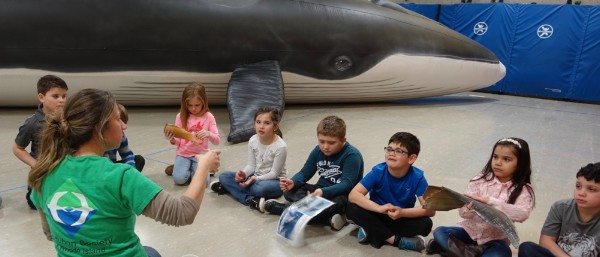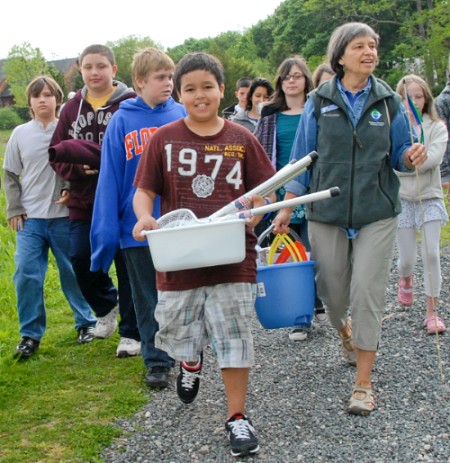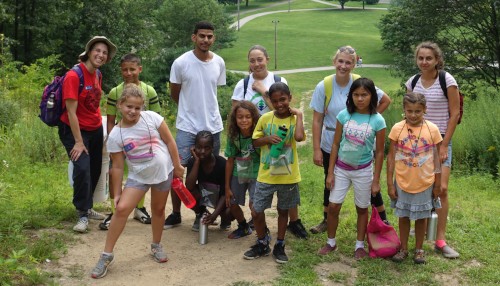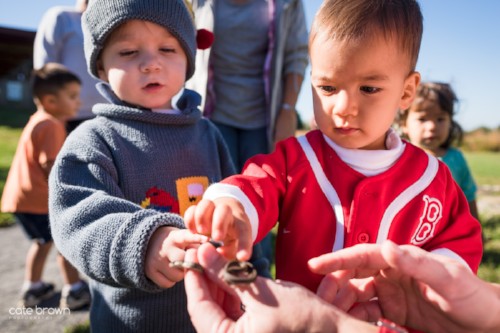Their First Brush With Nature
By Todd McLeish
On a chilly February morning in the brightly lit church hall adjacent to St. Kevin’s School in Warwick, 30 second graders gathered around Audubon environmental educator Lisa Maloney. They were learning about the adaptations animals have developed to survive the winter. Asking question after question to keep the children engaged, Maloney elicited answers about how a beaver stays warm, how its tail is used to communicate, and why the animals chew on tree branches, among many others.
The children could not have been happier. With every question asked, numerous students politely raised their hand to answer, and it was obvious they were pleased with the diversion from their usual classroom activities. When correct answers led to several children being selected to “model” a faux beaver vest, tail, teeth and flippers, it was clear by their smiles that the children were proud to stand before their classmates, despite their outlandish attire.
And yet the activities were just getting started in Audubon’s Animal Adaptations program. After dividing into groups, Maloney guided the students through activities at four education stations, where they matched photos of animals with the food they eat, manipulated a turtle shell, deer antler, racoon pelt and beaver skull, and discovered the seasonal activities each animal undertakes. While the noise level in the room rose precipitously during this part of the program, the students’ enthusiasm did, too. And it continued as they played a board game to learn whether particular animals “stay, sleep or go away” during the winter.
The highlight of the morning came when Maloney introduced the children to Autumn, a four-foot long corn snake, which immediately brought the students to rapt attention. Again, Maloney discussed how the animal’s physical attributes – like scales, coloration and tongue – help it survive in the environment. And then she encouraged each student to touch Autumn’s scales. “What does she feel like?” asked Maloney. “Is she wet? Slimy? Dry? What colors do you see on her scales?” It was clearly the most exciting moment of the children’s day, and a lesson they would not soon forget.

Audubon’s Inflatable Whale program educates students on whale biology, anatomy and adaptations.
Environmental education has been part of the Audubon Society of Rhode Island’s mission since its earliest days. And it didn’t take long for the Society to realize how critical it is to focus much of its education efforts on children.
Audubon educators are often the first to introduceRhode Island children to the wonders of the natural world. From L’il Peeps and summer camps to urban middle school programs and developing schoolyard habitats, Audubon is a leader in environmental education. Considerable time is spent dispelling fears and encouraging a love of science and nature among those who previously had little exposure to it.
Lauren Parmelee is the ideal leader for this effort. Audubon’s senior director of education, she said that she began her love affair with nature while still a toddler.
“Your brain is so malleable when you’re young, so if you spend time outside observing nature, it’s easy to get hooked. It becomes a part of who you are,” she said. “That’s why it’s so important for us to get young children outside and to encourage their caretakers to take them outside, too.
“But it’s not enough to introduce nature to kids just once; you have to nurture curiosity as they grow. And to do that, we have to build relationships with school systems.”
Audubon’s educational offerings have grown to be quite extensive. School programs now include hands-on science lessons for all ages in the classroom, at Audubon wildlife refuges, and in the Environmental Education Center in Bristol. Many programs focus on animal adaptations, senses, habitats and ecosystems, and all align with Next Generation Science Standards (NGSS are K–12 science content standards that set educational expectations for students. The NGSS were developed by states, including RI, to improve science education for all students.) Also offered are special programs on maple sugaring, geology and biodiversity. Interactions with live animals – from hawks and owls to snakes and turtles – are especially popular, as is a program that uses a life-sized inflatable whale to teach about mammal anatomy and adaptations. Outdoor field explorations at Audubon refuges introduce life in fields, forests, wetlands, ponds and coastal regions.

Students head to the outdoor classroom in Bristol to study life in the Wetlands.
After-school and summer science enrichment programs are offered in a variety of formats, including weekly series, one-time visits and field trips, and cover many of the same topics as the classroom programs. Audubon Explorers targets the elementary grades with environmental investigations of the schoolyard, visits with live animals, and nature games, while Urban Naturalists introduces middle schoolers to wild plants and animals in their neighborhoods, plus visits to parks, hikes and hands-on experiments.
The reaction from students and teachers alike is always overwhelmingly positive. Cindi Rapoza, who runs the Little Peeps Montessori School in Little Compton, for example, has scheduled monthly visits from Audubon -
including a live animal – for several years. She said that nature is a core part of her curriculum, and Audubon programs provide unique opportunities for her students to get close-up contact and education about native wildlife.
“The children look forward to their friends from Audubon visiting,” she said. “Young children often care about the well-being of all animals and insects. Since the animals Audubon brings into the classroom are usually rehabilitated and were once injured, the Audubon staff are heroes in the eyes of our children because they care for hurt animals.”
Renee MacDougall agrees. A second grade teacher at Rockwell Elementary School in Bristol, she has scheduled at least five different Audubon education programs in recent years, and they all complement and enrich the school’s science curriculum by allowing students to participate in meaningful hands-on experiences.
“The lessons spark excitement in our students as they provide experiences above and beyond what typical lessons can provide in a traditional school setting,” she said. “The students are also fascinated by the live animals that Audubon exposes them to.”
The positive student reactions don’t dissipate at the end of the program either. “My feedback from families is that children come home eager to share their knowledge and bird watching experiences with their families,” said Wakefield Elementary School kindergarten teacher Cindy Hagerty.
The teachers are also inspired by the programs, and with the help of Audubon’s educators, they will often follow-up with additional nature oriented lessons in the ensuing days and weeks. Rapoza, for instance, invites her students to dissect owl pellets after the visit from Audubon’s Barred Owl.
Parmelee said that is an important goal of Audubon’s education programs – getting teachers adept at bringing children outdoors so they will continue to do so after the Audubon visit concludes. For years Audubon has offered professional development workshops for teachers to help them become more comfortable teaching science, especially outside the classroom. But as school systems change and curriculum requirements evolve, Audubon has revised its approach to working with educators. Audubon often now works with teachers onsite, serving as a role model in encouraging schoolyard science.

Audubon educators bring summer camp to Neutaconkanut Park in Providence.
“It’s so important to take kids outside,” Parmelee said. “We serve as a model for teachers and caretakers, to show them how children become curious and engaged when they are in nature. The key is to give the adults some tools and the confidence to encourage outdoor science investigations and to expand on what we do.”
Lisa Maloney has been on the frontlines of environmental education for 25 years, the last 11 at Audubon. She grew up in the outdoors, exploring the woods, and loved making up stories about the animals that live there.
“That experience is what I hope I provide to the students I work with. That’s what fuels me,” she said. “Teachers have a lot of tools at their disposal, but they’re so busy that getting kids outside is often difficult.”
“So we try to connect with teachers to show them how to use their schoolyard as a field trip. With school budgets so tight, it’s difficult – especially for urban districts – to find money to travel. We try to meet kids in their own communities and get them outside to have an experience with nature right there.”
Maloney is especially enthusiastic when she leads the programs for preschoolers, which often includes nature stories, a live animal, and various activities.
“At that age, their eyes are opening to the wonder of the world around them, so it’s a perfect time to be out in nature with them,” she said. “Their observations are amazing – and hilarious. They’re like little scientists. It’s my favorite age group.”
Children aren’t the only audience for Audubon environmental education programs, however. The Society offers numerous programs for adult audiences as well, from lectures and birdwatching field trips to advanced birding classes and art projects of many varieties.
“We want to hook as many different people into learning about nature as we can, and different programs do that in different ways,” Parmelee said. “If you’re interested in art and we can help you learn to paint birds, then you’ll become interested in birds. What makes Audubon unique is the wide-ranging expertise our staff has, which allows us to offer so many great programs.”
But why bother? Why is it so important to commit so many resources to educating Rhode Islanders about the environment? Parmelee said the reason, in part, is to overcome the sense that humans are separate from nature and ecosystems.
“I’ve always felt that we are connected to and a part of nature, and yet so much of our culture teaches us that we are separate, or above, or more important than the ecosystem,” she said. “I believe that this lack of connection to the natural world has created so many of the environmental challenges we face today. And now we’re standing at a crossroads,” Parmelee added, “as climate change is impacting the world around us.”

Audubon reaches children as young as 18 months in the Li’l Peeps class.
“In order for us, as a human population, to make the right decisions we have to understand the ecosystem and how we are connected to it,” she continued. “The decisions we make on a daily basis matter to the planet. Today’s children will be affected by environmental challenges more than any previous generation. We all need to become more environmentally aware and connected to nature.”
That’s also why Audubon focuses some of its environmental education programs on urban youth who have little experience with nature. Many urban children are frightened of wildlife and wild places, and they think of it as something far away from where they live. So Audubon has partnered with the Providence After-School Alliance to offer middle school students field trips and other activities so they can learn to enjoy and appreciate the natural world. A similar after-school program for elementary and middle school students in Woonsocket, in partnership with the non-profit Connecting Children and Families, includes visits to a nearby vulture roost and a bridge over the Blackstone River where swallows and swifts congregate.
After one Providence middle school field trip to Audubon’s Powder Mill Ledges Wildlife Refuge, several students said how appreciative they were for the opportunity to explore nature.
“I was shocked,” she said. “You don’t hear that from middle schoolers. It made me so happy.”
As Audubon’s education programs continue to evolve, the staff is constantly thinking about new topics to feature and new opportunities to engage audiences of all ages. Zachariah the Raven is a newcomer to Audubon, and he will likely be featured prominently in future programs.
“We’re looking forward to building a program around bird intelligence and the problem-solving abilities of birds like Zachariah,” Parmelee said. “That could be translated on both a family level and an adult level. He’s an amazing bird, and people are already fascinated with him.”
Climate change is another topic that Audubon seeks to incorporate into its programs. But it’s a difficult subject to introduce to children, so Audubon educators are still talking about the appropriate age level and the most effective messaging.
“That’s one of our goals – and one of our challenges – going forward,” Parmelee concluded. “We’ve always taught children to appreciate nature, to recycle, not to litter, to plant a tree, ride bikes, and given them action steps they can take to help the planet. But how do you create messages about climate change that aren’t frightening or overwhelming? We want kids to be inspired, to become knowledgeable, to become our future
environmental leaders. We don’t want them shutting down because the topic of climate change is too complicated. We’re still working on that.”
Audubon educators have their hands full. They see more children connected to mobile devices with less and less time spent outside. They work with urban middle school students who have little to no understanding of the natural world. With climate change and other environmental challenges on the rise, limited funding stretches their capacity daily.
“Some people think of us simply as Audubon staff who bring those cool owls and other critters into classrooms,” said Parmelee. “Although animals are important, and we often connect to students through them, it’s the message we leave behind that’s critical. We are all part of nature, and we need to respect and protect it. That starts with education.”
Those interested in learning more about Audubon’s environmental education programs can visit the "Learn" section on our website.
• • •
Todd McLeish is a life-long birder, freelance science writer and author of several books about wildlife, including “Return of the Sea Otter”.

















